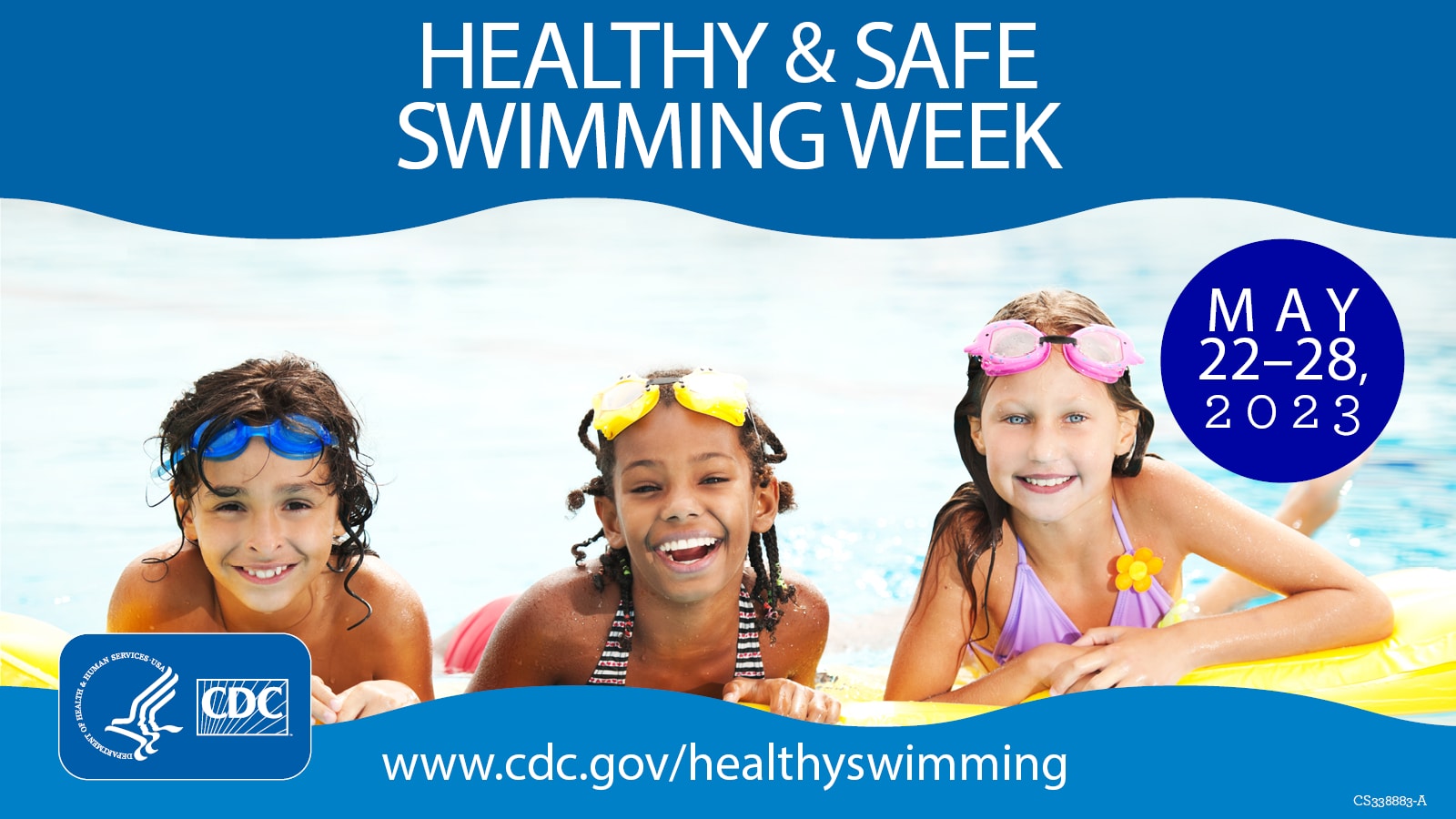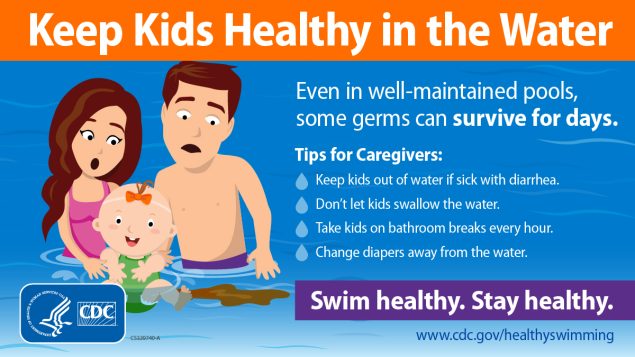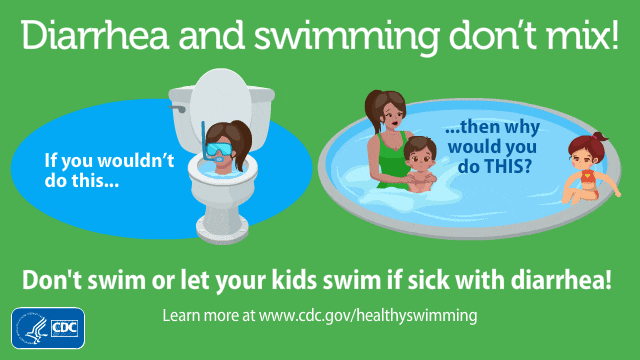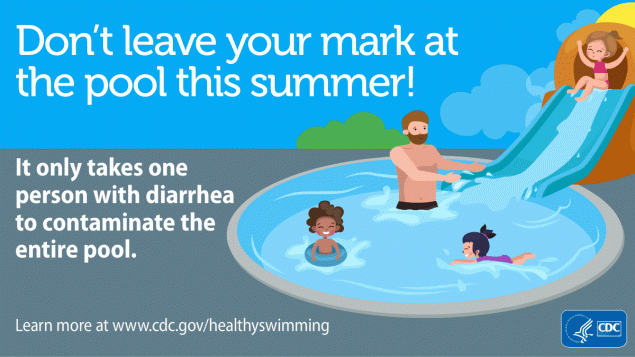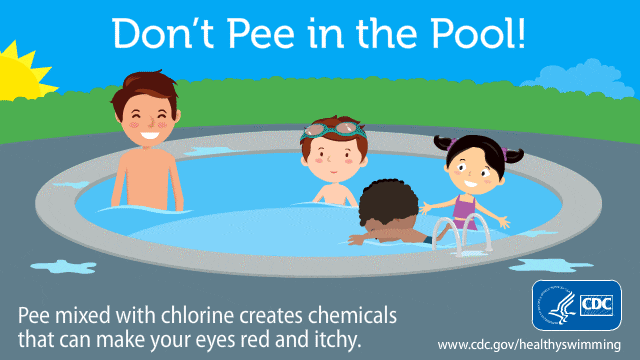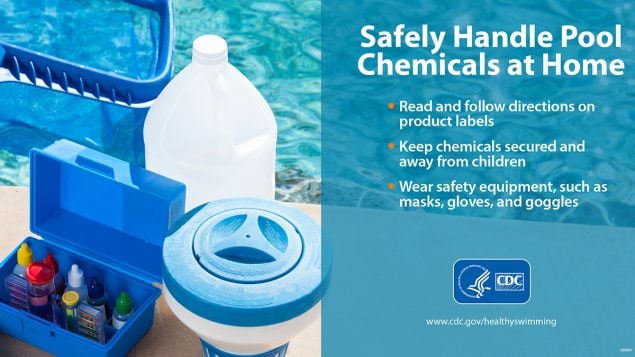Healthy and Safe Swimming Communications Toolkit

The information and materials below can help public health professionals promote healthy and safe swimming messages on social media, websites, and other communication channels during Healthy and Safe Swimming Week and throughout the year. These resources can be used to raise awareness about the steps everyone can take to protect themselves and those they care about from illness and injury in and around the water.
This year’s theme is Got Diarrhea? Don’t Swim!
All Audiences
- Post web content related to diarrhea and swimming on your organization’s website and share communication materials about healthy and safe swimming.
- Consider syndicating CDC’s healthy swimming web content directly onto your website without having to maintain it. When CDC updates the syndicated content, your website will be updated as well. Your site’s colors, fonts, navigation, and other unique properties will be unaffected.
- Use social media posts to spread the word about healthy and safe swimming.
- Disseminate healthy and safe swimming messages and materials (for example, in email announcements).
Media
- Provide a press release to media outlets (see Issue a Press Release).
- Share information on steps swimmers and caregivers can take to prevent swimming-related illnesses, drowning, and pool chemical injuries.
Operators of Treated Aquatic Venues (Pools, Hot Tubs, and Splash Pads)
- Check out CDC’s Model Aquatic Health Code and explore how it can be used to prevent illness and injury in and around aquatic venues.
- Explore forms, protocols, and other resources on our MAHC Tools and Training page.
- Share CDC’s latest guidance on the proper operation and management of splash pads.
Beach Managers and Operators of Untreated Aquatic Venues
- Tell beach managers to:
- Check out EPA’s online technical resources.
- Sign up for the Great Lakes Commission email group—known as Beachnet—to communicate and network with other beach managers across the country.
- Establish policies that allow employees to perform alternate duties that do not require entering the water if they have diarrhea or an open cut or wound that cannot be completely covered by a waterproof bandage.
Pool Supply Stores
- Recommend that stores display healthy and safe swimming communication materials, particularly those focused on pool chemical safety, in their stores and on their websites.
Healthcare Providers
- Encourage providers to share healthy and safe swimming communication materials with their patients.
- Engage your local chapter of the American Academy of Pediatrics or other organizations for healthcare professionals.
Community Leaders
- Create fact sheets for community leaders (such as program administrators, boards of health, and elected officials) detailing specifics about your agency’s Healthy and Safe Swimming Week efforts.
- Diarrhea and swimming don’t mix! Follow CDC’s steps for healthy swimming to help protect yourself and those you care about from illness at the pool. #healthyswimming https://go.usa.gov/xQRNZ
- Did you know swallowing even a small amount of water contaminated with diarrhea germs can make you sick for up to 3 weeks? Don’t swallow water at the pool or splash pad! #healthyswimming https://go.usa.gov/xsymt
- Don’t swim or let your kids swim if they are sick with diarrhea. One person with diarrhea can contaminate the entire pool. Learn more ways to help keep you and those you care about healthy. #healthyswimming https://go.usa.gov/xsymt
- Stay out of splash pads if you are sick with diarrhea. Jets can rinse germs found in poop off butts and swallowing the water with those germs can make you sick. Chlorine doesn’t kill germs instantly. Learn more: https://go.usa.gov/xzKtg #HealthySwimming
- Follow CDC’s steps for healthy swimming to protect yourself and those you care about from illness at the pool and beach this summer. #healthyswimming https://go.usa.gov/xQRNZ
- Pee in the toilet, not in the pool! When pee and chlorine mix in the pool, there is less chlorine available to kill germs. #healthyswimming https://go.usa.gov/xH8Wk
- #DYK that chlorine doesn’t kill germs in pools right away? While it kills most germs within minutes, some germs can live in a properly chlorinated pool for days! Protect yourself. Don’t swallow water you swim or play in. #healthyswimming https://go.usa.gov/xsymt
- Sweat and dirt on your body can use up chlorine needed to kill germs in the pool. Showering before you get in the pool keeps chlorine levels up to help keep you and those you care about healthy! #healthyswimming https://go.usa.gov/xQRNZ
- Going for a swim with kids? Take a break every hour to use the bathroom or check diapers. Change diapers away from the water to help keep germs from getting in. #healthyswimming https://go.usa.gov/xQRNZ
- Don’t swallow splash pad water. Did you know that it can take chlorine minutes—and sometimes even days—to kill germs in splash pad water? Swallowing water with germs can cause diarrhea or vomiting. Learn more: https://go.usa.gov/xzKtg #healthyswimming
Healthy and Safe Swimming Week Graphics
- Watch kids closely when they are in or around water. Drowning happens quickly and quietly, so avoid distracting activities like being on a phone. https://go.usa.gov/xuTBf
- More children ages 1–4 years die from drowning than any other cause. Learn what you can do to help protect children from drowning. https://go.usa.gov/xuTBf
- Help prevent children from getting in your backyard pool unsupervised. Install four-sided fencing which fully encloses the pool and separates it from the house, with self-closing and self-latching gates. https://go.usa.gov/xuTBf
- Help keep swimmers safe. Know how to recognize and respond to a swimmer in distress and how to perform CPR. https://go.usa.gov/xuTBf
- Teach children basic swimming and water safety skills. Swimming lessons can reduce the risk of drowning. Children who have had swimming lessons still need close and constant supervision when in or around water.
- Using your backyard pool? Pool chemicals protect us from germs but can cause injuries if not handled safely. Check out CDC’s pool chemical safety tips. bit.ly/40JQ681
- Using your backyard pool this summer? Help protect kids and pets by keeping pool chemicals out of reach. https://go.usa.gov/xuTZu
- Backyard pool owners: Make sure you know how to safely use pool chemicals to help keep everyone safe and healthy this summer. https://go.usa.gov/xuTBc
- Backyard pool owners: Order a FREE chemical safety use poster to learn how to safely use pool chemicals and help protect yourself, kids, and pets from injury. https://go.usa.gov/xv9H8
Pool Chemical Safety Graphic
In preparation for Healthy and Safe Swimming Week, local, state, territorial, and tribal communities can use and customize content from this template to develop their own press release to highlight healthy and safe swimming messages that best meet their community’s priorities and needs.
| What is the issue? | What we can do? |
|---|---|
|
Illnesses caused by the germs in pools, hot tubs, splash pads Germs in the water can make people sick if they swallow just a mouthful of contaminated water. Although most germs are killed within minutes by chlorine or bromine at the recommended levels, the germ Cryptosporidium (or Crypto) can survive for more than 7 days |
Take these steps every time you get in the water to help keep yourself and those you care about safe from germs. DOs
DON’Ts
For more info, visit CDC’s Communication Materials, Diarrhea and Swimming, and Steps for Healthy Swimming web pages. |
|
Drowning In the United States:
|
Stay safe in and around the water:
Help keep backyard pools safe:
For more info, visit CDC’s Drowning Prevention web page. |
|
Injuries caused by mishandling pool chemicals Pool chemicals, like chlorine, are needed to protect swimmers’ health. However, mishandling pool chemicals can cause serious injuries. Pool chemical injuries lead to about 4,500 U.S. emergency department visits each year, and over one-third of these preventable injuries are in children and teens. |
Take the following steps to prevent pool chemical injuries:
Prevent violent, potentially explosive, reactions:
You can order a FREE laminated CDC poster on using pool chemicals safely and download and print CDC posters on storing and using pool chemicals safely. For more info, visit CDC’s Pool Chemical Safety web page. |
|
Harmful Algae and Cyanobacterial Blooms Algae and cyanobacteria (sometimes called blue-green algae) can overgrow or bloom in warm, nutrient-rich water. Some of these blooms can harm people, animals, and the environment. These events are referred to as harmful algal or cyanobacterial blooms (HABs). If harmful algal or cyanobacterial blooms produce toxins, they can cause a variety of symptoms, including skin irritation, coughing, sneezing, diarrhea, stomach pain, numbness, and dizziness. Symptoms vary depending on the type of toxin and the type of exposure, such as skin contact, eating contaminated food, swallowing contaminated water, or breathing in tiny, contaminated droplets or mist. For more info, visit the Harmful Algal Blooms website. |
Avoid water that contains harmful algal or cyanobacterial blooms—when in doubt, stay out!
For more info, visit visit CDCs Harmful Algal Blooms and HABs: Protect Yourself and Pets web page. |
|
Naegleria fowleri (“Brain-eating Ameba”) Naegleria fowleri is a microscopic ameba (a single-celled living organism) that is commonly found in warm freshwater such as in lakes, rivers, and hot springs. If water containing the ameba goes up the nose, the ameba can invade and cause a rare and devastating infection of the brain called primary amebic meningoencephalitis (PAM). |
When swimming in freshwater, try to prevent water from going up your nose. Naegleria fowleri infections are rare. The only certain way to prevent an infection due to swimming in freshwater is to stay out of warm freshwater. However, you can reduce your chance of getting an infection by limiting the amount of freshwater going up your nose. To limit the amount of freshwater going up your nose:
For more info, visit CDC’s Naegleria fowleri: Swimming Precautions web page. |
